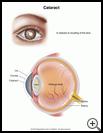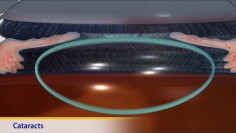
Cataract
What is a cataract?
A cataract is a cloudy area in the lens of the eye. The lens is located inside the eye behind the iris (the colored part of the eye). The lens gets cloudier with age and can cause vision problems.
What is the cause?
What causes cataracts is not known, but many things may make cataracts more likely to form, such as:
- eye injury or previous eye surgery
- diabetes or other diseases
- exposure to radiation, especially X-rays
- long-term use of steroid medicine
- exposure to medicines such as gout medicines, cholesterol lowering drugs, antibiotics, and diuretics
- inflammation in the front of the eye (iritis)
- prolonged exposure to sunlight
A child may be born with cataracts or develop them at an early age. These cataracts, called congenital cataracts, may be caused by:
- a genetic disorder (such as Down syndrome)
- a condition called galactosemia in which the body is unable to use the sugar galactose
- a condition the mother had during pregnancy, such as German measles
They also may be inherited.
Cataracts don't spread from one eye to the other, but many people have cataracts in both eyes. The cataract can be worse in one eye compared to the other.
What are the symptoms?
The symptoms of a cataract include:
- blurred vision
- a need for frequent changes in your eyeglasses or contacts
- glare from lights, especially at night
- being sensitive to bright light
- change in color vision (yellow, orange, and red appear brighter and blue appears dull)
Cataracts do not usually cause complete blindness. However, it is possible to lose enough vision to make it hard to recognize objects.
How is it diagnosed?
Cataracts are often found during a routine eye exam. An eye care provider will evaluate your symptoms and talk with you about the best treatment.
How is it treated?
Cataracts in young children should be removed to help prevent other eye problems. Cataracts in children are often linked to other problems with the eyes. This means the vision may not get better after cataracts are removed.
Cataract surgery is done to remove the cloudy lens and replace it with a new plastic lens in the eye. Lasers are not used to remove cataracts.
Surgery to remove cataracts is usually very successful in restoring vision. Although a cataract cannot grow back, your child may develop a cloudy film over the covering of the lens months to years later. This membrane can be removed using a laser.
How can I help prevent cataracts?
Having your child wear goggles or safety glasses during activities where your child’s eyes could be injured can lower the risk of eye injuries, This can prevent the possible development of cataracts. Wearing glasses with a UV coating that protects the eyes from sunlight might prevent or delay some types of cataracts, but this is not proven.
If your child has diabetes, good blood sugar control may slow the growth of cataracts.
Last modified: 2011-10-19
Last reviewed: 2011-10-10


